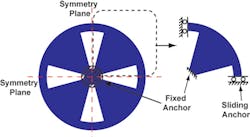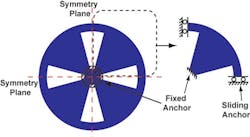RF MEMS Switches Deliver High Power In A Compact Package
This file type includes high resolution graphics and schematics when applicable.
Thanks to recent technology advances, some microelectromechanical-systems (MEMS) switches now outperform micro-relays or solid-state switches. In fact, MEMS technology has the potential to overtake conventional technologies in terms of linearity, power consumption, and insertion loss. Yet challenges must be overcome to implement viable RF MEMS switches—particularly in the handling of significant power levels and reliability. In order to find design topologies that could offer these benefits, an RF MEMS switch using radial cantilevers in an SPST and SP4T configuration was designed by Hosein Zareie and Gabriel M. Rebeiz of the University of California at San Diego.
Overcoming drawbacks of certain material properties is critical in the implementation of MEMS devices. To solve the high contact-resistance issues surrounding reliable and hard metals like ruthenium, for example, these switches are designed with multiple contact points and high contact force. The SPST is fabricated with a gap of 0.9 μm and a 5-μm gold beam. The cantilever sections are connected to form an eight-contact design. A sliding anchor is used to limit displacement to a single axis (see figure).
The SP4T typology is created in a manner similar to the SPST typology. It boasts four independent actuation electrodes at the output ports of each quadrant. For fabrication of a 500-μm high-resistivity silicon substrate, the UCSD process is used. According to results from an experiment, the SPST typology is capable of handling power levels beyond 2 W while the SP4T typology can handle upwards of 10 W over 100 million cycles. See “Compact High-Power SPST and SP4T RF MEMS Metal-Contact Switches,” IEEE Transactions on Microwave Theory and Techniques, Feb. 2014, p. 297.
This file type includes high resolution graphics and schematics when applicable.
About the Author
Jean-Jacques DeLisle
Jean-Jacques graduated from the Rochester Institute of Technology, where he completed his Master of Science in Electrical Engineering. In his studies, Jean-Jacques focused on Control Systems Design, Mixed-Signal IC Design, and RF Design. His research focus was in smart-sensor platform design for RF connector applications for the telecommunications industry. During his research, Jean-Jacques developed a passion for the field of RF/microwaves and expanded his knowledge by doing R&D for the telecommunications industry.


